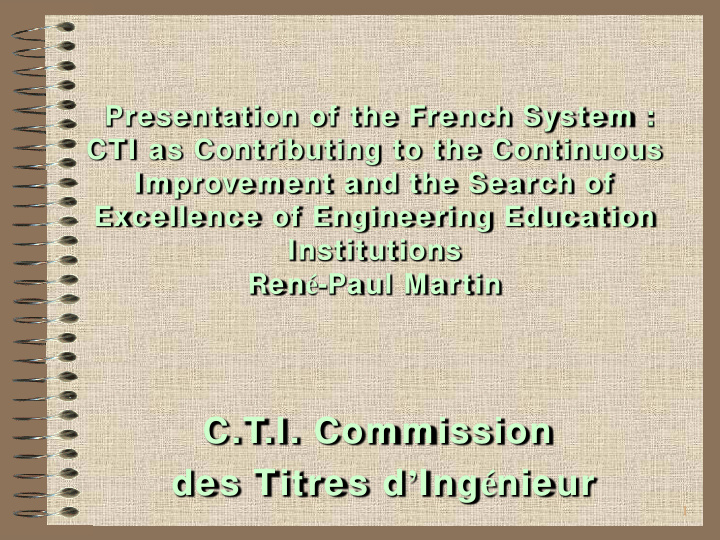



Presentation of the French System : CTI as Contributing to the Continuous Improvement and the Search of Excellence of Engineering Education Institutions Ren é -Paul Martin C.T.I. Commission des Titres d ’ Ing é nieur 1
C.T.I Commission des Titres d ’Ingénieur Since 1934 - Main characteristics : parity between academics and industrials 32 members Representatives of Academics from the 8 8 industry Min.of Higher Education Repres. of other Ministries Representatives of 8 8 and/or private institutes Engineering Assoc. And trade unions 2
CTI Missions • Accredit new engineering curricula • Periodically assess existing curricula (6 years) • Participate in the design of engineering training courses • Assist every body involved in engineering training in a global reflection on future evolution • Assess curricula, on requested, put forward by foreign institutions 3
CTI Missions CTI’s missions & roles : Outcomes 1. STATE SYSTEM : • CTI acts on behalf of the Education Minister • CTI acts as adviser to the Minister for Education and others • The governor in charge of any institute makes decisions following the CTI ’s recommendations 2. PRIVATE SYSTEM : • CTI acts on behalf of the Education Minister • The school makes its decision, after a meeting of the board of governors, in response to CTI’s comments. 4
Number of degrees awarded in engineering (1999) 1 - STANDARD TRAINING - Initial training 22280 - Specialization 1003 - Continuous education 377 - Promoting schools 934 2 - OTHER TYPES OF TRAINING - Qualified engineer : industrial techniques 1507 - State recognized engineers 120 TOTAL 26221 (25098 in 1996) 5
CTI Engineering training in France Major trends • Mathematics as a tool for modeling • Basic physics and chemistry (all students) • Detailed knowledge of the curriculum specialty • Broad training in communication, social and human sciences, management, etc. • Fluent use of one, preferably two, foreign language, including English; ability to work in a foreign environment • Professional skills developed by alternation and project work in industry 6
CTI • Status and organization of an institute delivering the degree of « qualified engineer » 1 - CTI defines the institute by an « entrepreneurial » model 2 - Four principles : - legal recognition - autonomy - external members of the board - strong management 7
CTI International awareness 1 - The practice of foreign languages 2 - Foreign students at the institute and student exchanges 3 - Recognition / accreditation involving foreign institutes 4 - Degrees awarded by foreign institutes 5 - International recognitions : memorandum of understanding with ABET 1998,agreement for mutual recognition between CTI and Canadian Engineering Council dated 21 september 1999 6 – Bologna agreement and engineering studies in France 8
Bologna Agreement &Engineering studies in France • Usual scheme in France • Bologna scheme • 2 years general • 3 years of general education scientific and maths,physics,chemistry technological • 3 years sciences for education Equivalency engineering, technology with Bachelors’s study and projects Specialization, • 2 years of specialized management and engineering education communication, foreign Equivalency with languages Additionnal Master’s degree management etc highly specialized formation, 4- 6 months stay in 9 industry
CTI Gateway to working in industry 1 - Alternation : standard training Cooperative education - Apprenticeships 2 - Project - based learning 3 - New technologies 4 - Increasing industrial participation in the training of engineers 5 - Development of entrepreneurship 10
CTI criteria 1 - General presentation of the establishment (new curriculum; global environment of the school; etc) 2 - Curriculum (detailed organization of studies; balance between scientific, technical, and general programs; student recruitment procedures, presence of foreign students; part of continuing education : assessment procedures of students, industrial block release) 3 - Human resources and scientific environment (number and quality of scientific staff : research activity : coure-related research etc.) 4 - Finance, equipment and premises (premises; educational equipment, resources; assessment of training costs,..) 11
The European Model for Total Quality Management, EFQM Results Personnel staff Personnel Results Process : Strategy Customers Leadership Key results of Excellence Resources Results partnerships Collectivity Results Resources 12
The European Model for Total Quality Management, EFQM Process : Operational Management of Satisfaction Leadership staff and students of personnel results Recruitment - Strong Student skills Tutorship government Employment Syllabus Curriculum of graduates Satisfaction of - Policy of the Projects - Design, Industrial, students board, Research International Labo Strategy awards internhips Reputation of - General Training management Participation the institute Exams Resources in university life, Financial - Autonomy city life equilibrium, etc. Results Resources 13
CTI Utility : an example 1 - Renewal for 6 years is not automatic 2 - Results : 129 accreditations for 6 years 29 accreditations for 3 years 6 accreditations for 2 years 4 accreditations for 1 years 14
Conclusions 1 - CTI has defined its orientations and references, close to ISO and EFQM models 2 - CTI notification are followed by actions 3 - CTI has the role of adviser, not censor 4 - CTI fosters alignment with other national systems 15
Recommend
More recommend